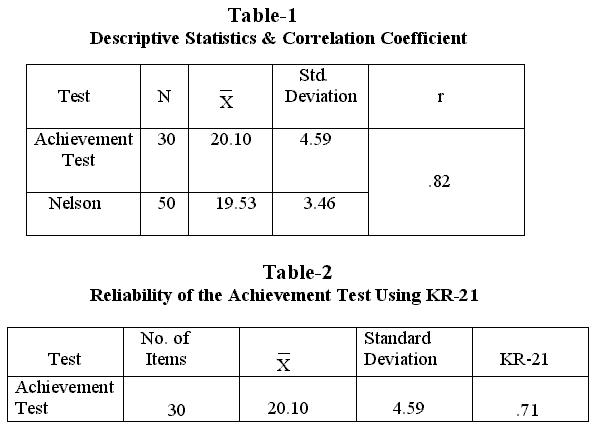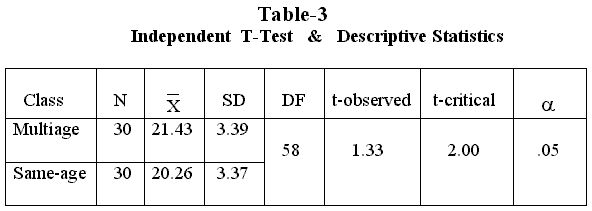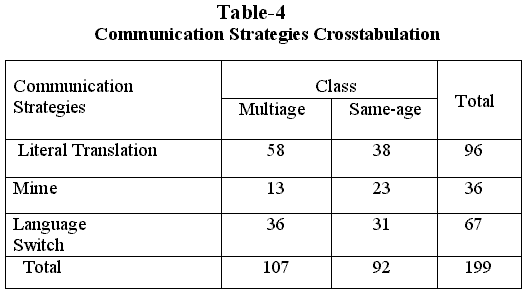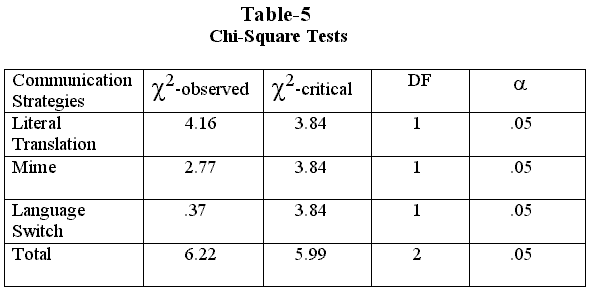 Teacher Feature...
Teacher Feature...
The Role of EFL learners' Heterogeneity in Terms of Age in Their Use of Communication Strategies
by Yahya Ghelichli, Khatam University, Iran
The objective of the present study was to investigate the role of EFL learners' heterogeneity in terms of age in their use of communication strategies. However, as a secondary objective, the probable impact of such a context on the students' overall achievement was also explored. To this end, two classes were studied: the students of one class were at the age of 15 & 16 (the same-age class), and those of the other class were of different ages, from 15 to over-35 (the multiage class). The results obtained suggest that the students' use of communication strategies is affected by the context of situation and interlocutors. Nonetheless, no difference was observed in the students' overall achievement.
Introduction
Interest in communicative language teaching has led researchers in applied linguistics to focus on the use of communication strategies (CSs) by second language (L2) learners (Littlemore, 2001). Communicative language teaching builds on the understanding that language use is governed not only by phonological and grammatical rules, but also by sociolinguistic and discourse rules (Canale & Swain, 1980). In other words, natural language use is a complex, creative activity that takes different forms depending on a variety of factors, including the context in which the interaction occurs, the characteristics of the speaker or writer (for example, age, gender, social status, level of education, and geographic origin), the characteristics of the listener or reader, and the purpose of the interaction (Hymes, 1972). On the other hand, the study of CSs is important, as it looks at how learners are able to use the L2 in order to convey meaning. Accordingly, a class where there are students of different ages can be a context that may probably be important in the students' progress and their use of certain communication strategies. To this end, the following research questions were formulated:
- Does the EFL learners' heterogeneity in terms of age have any significant effect on their overall achievement?
- Is there any significant relationship between the EFL learners' heterogeneity in terms of age and their use of communication strategies?
Background to the Study
Hundreds of years ago, students learned in a one-room schoolhouse. In such a setting, students of all ages were educated together by the same teacher for several years. Such a class provided a community atmosphere where students worked and learned together. While there are different names and forms of multiage classrooms, the essential concept involves combining different age groups within one classroom (Naylor, 2000).
There are two reasons why multiage classes exist: one reflects a philosophy; the second relates to administrative considerations( Naylor, 2000). The former reflects a deliberate and systematic mixing of students of different ages as desirable and as beneficial to students. The second reason for the existence of what are usually defined as multi-grade classes is more mundane, and was stated by Veenman (1995) as to be an administrative device used to cope with declining student enrolment or uneven class size. In this context, classes are combined because there are simply not enough students to form a single-grade class.
In the realm of second language learning, however, multiage classrooms have not been paid much attention to date. In most cases, the language learner may be put in a class regardless of his/her age, the deciding factor being his/her level of language proficiency. Of course, the term multilevel is used to identify any group of learners who differ from one another in one or more significant ways. Arguably, every class is multilevel because learners begin with varying degrees of competence and then progress at different rates in each of the language skills (Bell &Burnaby, 1984). However, in many EFL and ESL classes, there are more variables that affect the levels within the class: the type and amount of a learner's previous education, the learning style preference, learner expectations of appropriate classroom activities, and the culture, religion, sex, and age of each learner (Guglielmino & Burrichter, 1987 ). Nevertheless, the language learner, whether put in a multiage class or in a same-age one, may resort to employ different strategies, when encountering problems in communication (Tarone, 1981; Faerch & Kasper, 1983).
In communicating with others, the learner may face problems. These problems are tackled through the application of some strategies. These strategies are referred to as communication strategies (Faerch & Kasper, 1983). They represent "potentially conscious plans set up by the learner in order to solve problems in communication" (ibid, p.39). These communication strategies, however, are not so easy to identify or to define, but two criteria are commonly applied. The first is that the strategies are problem oriented (Ellis, 1987). The second criterion is that these strategies are consciously employed or, at least, that they are potentially conscious (Faerch & Kasper 1980). That is, they are employed by the learner because he/she lacks linguistic resources to express his/her intended meaning, or, as Corder (1978) puts it, when there is a lack of balance between means and ends.
Communication Strategies Adopted for the Present Study
Faerch and Kasper (1983) hold that the difficulty of the analyst's task varies with the stand one takes in defining CSs. Thus before examining the typology of CSs for the purposes of the present study, it is necessary to clear the air concerning the view adopted here towards CSs. The meaning of CSs as used in the study is borrowed from Tarone (1981) who refers to them as "compensatory means" used by an SL learner when he/she is not able to communicate the original goal in the way previously planned, and so is forced to use alternative means to express it. Moreover, the approach the researcher adopted was interactional. Therefore, the typology of CSs to be suggested below is dependent on this interactional view. One obvious advantage of adopting the interactional definition is that it is easy to apply to performance data.
Accordingly, the following types of CSs, which were frequent in the various taxonomies of CSs in the literature (Tarone, 1981; Faerch & Kasper, 1983; Bialystok, 1983; Tarone & Yule, 1989), were chosen. Also the adopted CSs were more common than others in the pilot study conducted prior to the main research, given that the subjects in that pilot study were beginners as well. One apparent merit of selecting these strategies of communication was that they were easy to be specified in the performances of the language learners. The adopted CSs for the analysis in this study were as follows:
a) Literal Translation or Transliteration
The learner translates word for word from the native language:
e.g. " He's standing near to the desk."
For " He's standing near the desk."
b) Mime or Gesture
The leaner uses nonverbal strategies in place of a lexical item:
e.g. using mime for asking permission to leave the class.
c) Language Switch or Code Switching
The learner uses the native language term without bothering to translate
e.g. "My father is… Karmænd [for "an employee"]."
Method
Subjects
The participants of the study were 60 EFL male learners studying English at level Basic Two at the Iran Language Institute (ILI), Gorgan branch, Iran. They were selected among about 150 students, using a language proficiency test. This test was given to the students in order to homogenize them in terms of General English Proficiency (GEP). Then they were assigned to two classes. The students of one class were of about the same age (15&16), and those of the other of varying ages, from 15 to over-35. Therefore, the former was homogeneous with regard to sex, age, and GEP; the latter homogeneous in light of sex and GEP, but heterogeneous in terms of age.
Instrumentation
In order to obtain data regarding the application of communication strategies, the present researcher adopted video recording, for it was more objective and he had more time for detailed analysis of the data.
As it can be understood from the first research question, an achievement test was needed for this purpose. This test was made based on the materials which were covered during that term in the pilot study. This achievement test was first given to a group of students of the same level at the same institute.
The validity of this achievement test was estimated through correlating the students' scores on this test with those on the Nelson English proficiency test. The reliability of the test was also estimated against KR-21 formula.

Click the image for a larger view.
This achievement test, as the above tables show, enjoys high validity (.82 ) and reliability (.71 ).
Procedure
This study was conducted in the summer term of the ILI, Gorgan branch, in 2001. After the administration of the Nelson English proficiency test, about 85 students got 30 or over out of 50. Then 60 students were randomly selected for the two classes: same age class and multiage class. Therefore, the students of the same-age class were of 15- and 16-year-old students, and those of the multiage class of different ages -- from 15 to over-35.
Results
Regarding the first research question, and based on the students' scores obtained on the achievement test, an independent t-test was run to see whether the difference in the means of the two classes was significant. Table-3 shows the results of this test.

Click the image for a larger view.
As it can he seen in table-3, the amount of the t-observed (1.33) is less than the t-critical(2.00)with 58 degrees of freedom at .05 level of significance. This suggests that the difference observed is not meaningful. Thus, the null hypothesis of " The EFL learners' heterogeneity in terms of age has no significant effect on their overall achievement " is confirmed.
On the other hand, in order to answer the second research question, four chi-square tests were employed.

Click the image for a larger view.

Click the image for a larger view.
The total chi-square value obtained through performing these tests was  (with df = 2, at .05 level of significance), which is greater than the critical value of (with df = 2, at .05 level of significance), which is greater than the critical value of  ( table-5). This implies that there is a significant difference between the two classes in deploying communication strategies. Therefore, the null hypothesis of "There is no significant relationship between the EFL learners' heterogeneity in terms of age and their use of communication strategies" is rejected. In addition to this chi-square test, for each strategy additional chi-square tests were employed. The results of applying these tests together with the frequency of use of the specified communication strategies are presented in tables 4 and 5. ( table-5). This implies that there is a significant difference between the two classes in deploying communication strategies. Therefore, the null hypothesis of "There is no significant relationship between the EFL learners' heterogeneity in terms of age and their use of communication strategies" is rejected. In addition to this chi-square test, for each strategy additional chi-square tests were employed. The results of applying these tests together with the frequency of use of the specified communication strategies are presented in tables 4 and 5.
Discussion
The t-test conducted to probe the first research question indicated no significant difference between the means of the two classes on the achievement test. Therefore the first null hypothesis is confirmed.
One factor may be the fact that most of the language learners' effective learning takes place not simply inside the classroom. Chastain (1988) believes that learning context plays a role in learning, but it may not be so efficient as the use of other influential factors,e.g., learning strategies, which are, according to Oxford (1990), mostly used outside the learning environment. In fact, students seem to rely primarily on their learning outside classroom; hence the effect of the learners' heterogeneity in light of age minimizes. Thus, it may probably be inferred that the presence of classmates of various ages ( in this study, from 15 to over-35 years old ), does not have a significant effect on their final success.
In addition, most researchers of multiage classes ( Katz et al., 1990; Gausted, 1997; Naylor, 2000) emphasized the length of the learners' being together for at least more than one year. Whereas the length of the term in the present study was two and a half months, i.e. , 22 sessions. Therefore, this might have been an insufficient period of time to observe the impacts of the learners' heterogeneity in terms of age on their overall achievement.
A final factor that might have had an impact on the results can be the effects of the testing method. Since the learners' overall success in this study was measured through a multiple-choice test, it can be argued that this mode of testing may not have been suggestive of learners' achievement. In this regard, Bachman (1990) holds, "test performance is also affected by the characteristics of the methods used to elicit test performance (p.111)." Accordingly, it can possibly be said that the learners may perform differently on a different test method, which, in turn, can be an impetus for further research on the topic.
Nevertheless, the mean score of the multiage class was somewhat higher, however not significant, than the same-age one. This, as Ur (1996) maintains, may have its roots in such factors as educational level, world knowledge, motivation, and the like.
On the other hand, the results of the chi-square tests revealed a significant difference concerning the employing of the specified communication strategies between the students of the multiage class and the same-age one (see table-5). This is in favor of Chastain's (1988) idea that learner's use of communication strategies varies as the situation and interlocutors change. Moreover, Corder (1981) maintains that the strategies adopted by speakers depend upon their interlocutors.
Table-5 also shows that the main difference between the students of the two classes is in the frequency of use of literal translation. However, the difference in the frequency of use of the other two communication strategies, ‘mime' and ‘language switch', is not statistically significant.
What is interesting to note is that the highest frequency was the use of literal translation, followed by language switch and mime. This might be attributed to the level of the L2 learners. Since they were at lower levels of language learning, they were naturally less aware of the differences between English and Persian language structures. Therefore, they translated literally what they had in mind from Persian into English; and the resulting utterances often belonged neither to English, nor to Persian, but rather to what is called the learner's interlanguage.
Although, the results of this study do not bear much on the range of different communication strategies, they do inform us about the importance of the role of the situation and interlocutors as well as the strategy users themselves in employing particular communication strategies.
Conclusions, Implications, and Suggestions for Further Research
Briefly stated, using a descriptive design, this study examined two classes -- multiage class and same-age one -- to see the effects or roles of such contexts on the learners' overall success in language learning and in employing given communication strategies. To address the first research question concerning the students' success, an achievement test was given to them. Then using a t-test, the scores of the students of the two classes were compared. The t-observed(1.33) was less than the t-critical (2.00), verifying the first null hypothesis of " Language learners' heterogeneity in light of age has no significant effect on their overall achievement."
As stated earlier, this might be due to some factors. One factor can be the fact that most students rely on their learning outside the classroom environment, hence, minimizing the probable effects of the classmates' ages. Another factor may be the rather short length of the term ( about two and a half months ), which may not be sufficient to see the real impacts of learners' heterogeneity with regard to age on their overall success. Finally, a last factor, which might have been influential, can be the mode of testing, which was a multiple-choice test.
On the other hand, to explore the role of such contexts in the learner's use of certain communication strategies, four chi-square tests were run using the communication strategies checklists. The results of this test ( , with df=2, at , with df=2, at  = .05 ) showed a significant difference between the students of the two classes regarding the use of the specified communication strategies. = .05 ) showed a significant difference between the students of the two classes regarding the use of the specified communication strategies.
Already there is a fairly general consensus that the strategic competence of L2 learners is likely to be developed through genuine communication situations (Stern, 1978; Swain, 1980; Bailystok, 1985). Thus in a situation such as a classroom, it is important to provide opportunities for the language learners to communicate their thoughts.
To sum up, as the main conclusion of this study, it may be stated that the language learners' heterogeneity in terms of age has no significant impact on their overall achievement; however, it has a significant role in the learners' use of certain communication strategies among the subjects examined here. Finally, it is hoped that these results will also help stimulate further research yielding more definitive information on an apparently significant characteristic of the speech behavior of foreign language learners.
The results of this study may have important implications for language teachers and learners. At lower levels of language learning, assigning students of different ages ( in this study from 15 to over-35 ) to a single class may not have significant impacts on the learners' language learning. Furthermore, language learners need not worry about their success in case they were put in a class of students of varying ages.
As discussed earlier, this study investigated the lower level language learners of a multiage class and a same-age one in relation with their success in language learning and with their use of given communication strategies. Since, as far as it is known to the researcher, little work has been published to date, specifically dealing with the objectives of the present study, the findings presented here should still be regarded as preliminary and in need of further research.
Because of its limitations, this study did not consider some other important factors which may have an effect on the students' success and also a role in the learners' use of particular communication strategies. The effect of such a factor as the learners' sex on their overall achievement, and its role in employing certain communication strategies can be another topic for further research.
Moreover, the subjects in this study were language learners at lower levels of language learning. Further studies can be done on more proficient learners of language.
Finally, the types of communication strategies examined in this research were transliteration, language switch, and mime. Further research can explore the application of the other communication strategies among the language learners.
Acknowledgements
The researcher wishes to take the opportunity to express his sincere appreciation towards Dr. Ataei, advisor to this study, for his invaluable encouragement and painstaking guidance and counsel in all phases of the study. He is also indebted to Dr. Babaei, reader of this research work, for her meticulous efforts for all the research phases to the accomplished properly and for her precious suggestions and advice on the thorough reproduction of the final research report. He also records a debt to all those students who took part in this study.
References
Bachman, L. F. (1990). Fundamental considerations in language testing.Oxford: OUP.
Bialystok, E. (1978).A theoretical model of second language learning. Language learning. 28: 69-83.
Canale. M. & Swain, M. (1980). Theoretical bases of communicative approaches to second language teaching and testing . Applied Linguistics,1: 1: 47.
Chastain, K. (1988). Developing second language skills . Orlando: HBJ.
Corder, S. P. (1981). Error analysis and interlanguage . (4th ed.). Oxford: OUP.
Ellis, R. (1987) . Second language acquisition in context. Englewood Cliffs, NJ : PTI.
Faerch, C. & Kasper, G. (eds) (1983). Strategies in interlanguage communication . London: Longman.
Hymes, D. (1972). On communicative competence . In J. B. Pride & J. Holmes (eds.). Sociolinguistics. Harmondsworth: Penguin.
Littlemore, J. (2001). An empirical study of the relationship between cognitive style and the use of communication strategy. Applied Linguistics. 22/2: 241-265.
Naylor, Ch.(2000). Split-grade and multiage classes:a review of the research and a consideration of the B.C. context.BCTF Research Report.[on-line] Available: http://www.bctf.bc.ca/Research
Reports/2000ei02/report.html.
Fundamental concepts of language teaching . Oxford: OUP.
Ur, P. (1996). A course in language teaching . Cambridge : CUP.
Veenman, S. (1995). Cognitive and noncognitive effects of multigrade and multiage classes: a best evidence synthesis . Review of educational research . 65/4 : 319-381.
| 
